Popular varieties
The culture is quite popular and unpretentious. This gives breeders a reason to develop new varieties.
Franzois Ortegat
Terry tall shrub with hemispherical dark red flowers, has a strong aroma. The diameter of the inflorescence reaches 14 centimeters. The culture is frost-resistant, abundant flowering.
Paul M. Wide
A variety with dense semi-double red flowers, up to 17 centimeters in diameter. Peduncles are strong, therefore they do not require support. For the winter, it is recommended to cover it with a layer of peat and compost.
Kansas
A beautiful non-capricious representative of the species, with double bright red and white flowers. On long stems - up to 1 meter, wide dark green foliage is located.

Lactiflora
The bush has flower petals of white or pale pink color, up to 20 centimeters. Its leaves are dark green, double pinnate. The variety is used in traditional oriental medicine.
Bernhard
The culture has pearl pink, lilac inflorescences and a strong aroma. The variety is unpretentious and can withstand low temperatures.
the charm
A voluminous flowering bush grows up to 1 meter. Differs in a variety of semi-double or plain colors:
- cream;
- white;
- red;
- pink.
Looks beautiful in a group composition and as an independent plant.
Sword Dance
The variety has simple, bright red flowers, with a pronounced bunch of stamens and pistils. The bush needs protection from strong winds and sunlight.
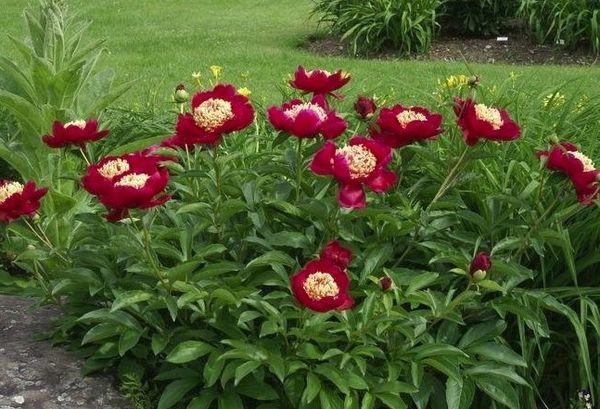
Nancy Nora
The culture is distinguished by delicate, pale pink, double inflorescences, light aroma, lush dark green foliage. The variety needs nutritious non-acidic soils.
Yellow
The culture has stable peduncles, on which are located yellow flowers up to 19 centimeters in diameter. Differs in strong winter hardiness.
Sarah Bernhardt
The variety has semi-double dense flowers. Long stems adorn the multifaceted and semi-double caps of red and white inflorescences.
Ed
The herbaceous plant has a height of 1-1.20 meters. Terry flowers of dark pink color, with a lilac tint, have a diameter of up to 15 centimeters. In Central Russia, the culture of shelter does not require.

Coral charm
The herbaceous interspecific hybrid changes color during flowering from pink-orange to baked milk. The bush has narrowed leaves, tall stems and semi-double flowers.
Sorbet
The culture has dense semi-double flowers. The shade changes from pale pink to creamy white in alternating layers. Peduncles are stable and do not require support.
Coral Sunset
Large bright petals of the variety have a pale salmon color with a bright red tint. The bush is abundantly covered with lush green foliage and has good frost resistance.

Monsieur Jules Elie
The representative needs a sunny place and loose, nutritious soil. The inflorescence has a light pink, lilac shade with silvery tips on the petals.
Inspector Laverne
The culture loves moisture and fertile soil, grows in the shade and in sunny places. The plant has erect, sometimes slightly branched stems, with crimson flowers and a delicate aroma.
Growing a flower
The cultivation of this variety of peonies can be done by gardeners of any level, since it is quite simple. It is recommended that you remember a number of basic rules that will help you grow a high quality plant.
Planting by root cuttings
A root cut is usually called a part of the root system with a growth bud and root. They are harvested before the formation of white roots. You can start planting cuttings in early August. To do this, you should:
- Dig out the rhizome of the peony, remove the soil, remove rotten and dried roots.
- Divide into as many cuttings as possible (each should have a bud and root).
- Soak the cuttings in potassium permanganate for 2 hours.Treat the cuts with charcoal.
- Plant in a substrate at a distance of 18 cm from each other.
Note! Planting is recommended to be protected from the sun at noon, to water and remove weeds. Shelter is recommended in winter
In a couple of years, it will be possible to find a new place for the plants.

Rhizome division
It is recommended to dig up peonies in order to replenish the stock of cuttings in the second half of August. It is worth planting either in September or early October. In this case, the seedlings are more likely to take root and survive the winter.
Seat selection
The choice of location is an important nuance for many colors. Peony Monsieur Jules Elie is no exception. It is recommended to plant it either in sunny areas or in partial shade. An absolute shadow can negatively affect flowering - it will not. However, when planting in the sun, it is advisable to find a way to shade the plant during particularly hot hours.
Important! It is not recommended to plant this peony near large bushes and trees, as it loves light. You should also avoid places where groundwater is too close to the surface, as this can cause rotting of the root system.
How to prepare the soil and flower for planting
The soil for growing this variety of peony should be light, good for air and water, and also be fertile. The best option is to choose loam. It is recommended to choose neutral acidity, since the peony does not like acidic soil. For the manufacture of the substrate, it is recommended to take peat, sand, humus and garden soil in equal proportions and mix thoroughly. It is also worth adding a small amount of woody soil and mineral fertilizers to it.
Depending on the method of reproduction of the plant, the flower is prepared in a certain way. If we are talking about seeds, then it is worth following the rules of artificial stratification, if about root cuttings, disinfection with potassium permanganate and charcoal is necessary. The treatment with a root formation accelerator remains the same.
Planting procedure step by step
There are not so many landing rules so that you can make a mistake at least at some stage.
- It is worth digging a hole 60-70 cm deep and 1 m in diameter in advance. This is required so that the roots of the plant can spread without problems.
- If the soil is acidic, liming is necessary, if loose, you will have to add humus, dense - add sand, if the groundwater is close to the ground, it is worth filling the drainage at the bottom of the hole.
- Fill the hole in half with the prepared substrate, place the seedling, gently straightening its roots. The renewal bud should be approximately 5 cm above ground level.
- Drizzle.
The procedure is simple, and therefore even a novice gardener can cope with it.

Landing
Seed planting
The seed method of growing peonies is used either for selection or for obtaining a large number of plants. This method has a number of disadvantages: flowering can be delayed for 3-7 years, only about a third of purchased seeds can emerge. If it is impossible to use other options for one reason or another, it is recommended to follow the step-by-step instructions.
When buying seeds, you need to pay attention to their appearance. If they are shriveled, then it is better not to buy them, but from shiny and smooth ones, a real plant can turn out
First of all, it is recommended to hold the seed in warm water for 24 hours, and then soak it in a solution of potassium permanganate for a few more hours. Subsequently, it is recommended to treat the seeds with a growth stimulant.
First, you need to plant them in a container, and after the first shoots appear, transplant them into open ground. In this case, artificial stratification is needed. This is done in the following way: the seeds are sent at the end of April to the freezer for a couple of months.
At the end of June, it is worth pulling them out and planting them in the ground, sending the container with them to the windowsill.The boxes with seeds should be taken out into the garden and covered with spruce branches for the winter. In the spring, sprouts should hatch from the seeds, which should be planted in the garden.
Peony Monsieur Jules Elie

A fairly large number of varieties of peonies are distinguished by the tenderness of the inflorescences due to the amazing shade of the petals. This feature is also characteristic of the variety of the specified plant, called Monsieur Jules Elie. As soon as you see her, you will like her and will surely become the true treasure of your flower garden.
History of origin
Monsieur Jules Elie is a French variety, bred in 1888 and therefore considered historic. Its author is the breeder Crousse Félix. In catalogs and other information sources, this culture is often listed under the name "Monsignor Jules Elie".
Description of the variety
This culture belongs to the group of lactic-flowered peonies and belongs to herbaceous perennials. Outwardly, it looks like a short, up to a meter, shrub with strong, erect or slightly branched stems and dark green, matte foliage of medium size.
This is an early flowering plant. The inflorescences formed on it are large, with a diameter of 18-20 cm, double, bomb-shaped. They give the impression of huge fluffy balls, consisting of narrow petals with a silvery coating on the edges.
The central part of the flower is crowned with a crown of petals bent inward. The lower petals of the inflorescence are rather wide, straight or slightly bent. But the flowers blooming on the plant are most attractive because of their light pink-lilac color.
In addition, the buds of this peony are also very fragrant.
Thus, when cultivating a decorative perennial in central Russia and, especially, in the southern regions, it does not need any shelter. Its resistance to pests and fungal diseases is average, as well as to rain. Fragrant flowers, as a rule, do not fade in the sun.
Due to the fact that the shoots are strong and do not bend under the weight of the globular inflorescences, the ornamental bush does not need support.
Growing and care
The place for the French beauty Monsieur Jules Elie should be chosen sunny or in partial shade. It is better to refuse to place the culture in a shady corner of the garden, because otherwise you will not wait for the perennial to bloom.
When planting a shrub where direct sunlight will fall on it for most of the day, take care of shading it during especially hot noon hours. Another point: since peonies love space, do not place the crop near large shrubs and trees.
Also, avoid planting sites that are close to the soil surface of groundwater, so as not to provoke rotting of the root system.
The plant is planted in a previously prepared hole about 60 cm deep, covered with a soil mixture of peat, sand, humus and garden soil, taken in a ratio of 1: 1: 1: 1.
Do not forget to add a little wood ash and about 200 grams of mineral fertilizer (preferably superphosphate) to the substrate used. Deepen the root system of the plant so that the buds are 4-5 cm below the surface of the soil.
The owner of chic inflorescences needs regular watering, carried out 1-2 times a week in a moderate mode. Cold and hard water should not be used for this procedure. Pour 1.5-2.5 buckets of settled liquid under one bush.
Peony top dressing is periodic.
Twice a month, the soil under the flower must be loosened
It is important to do this while the substrate is still damp after watering. Along the way, remove weeds from the roots that grow in the area of the trunk circle
After the moistening procedure, in order to retain moisture in the soil for a long time, it is recommended to mulch the soil under the peony with dry grass, sawdust or compost.
In late autumn, the perennial shoots are cut shortly so that a low stump forms instead of a bush.It is covered with dry soil, compost or dry foliage. In the northern regions, the culture should be covered with spruce branches or special insulation, but not with plastic wrap, to avoid damping out.
Use cases
It will not be difficult for Monsieur Jules Elie to find a place in a garden, a flower garden or a front garden. Its pink flowers with a lilac sheen contrast remarkably with the bright background of the grass lawn and the dark green needles of evergreen plants - junipers, firs, thujas, fir, boxwood, pines.
In mixed plantings, Monsieur Jules Elie is wonderfully combined with fragrant herbs and cereals with silvery leaves and lilac, blue, pink, white inflorescences. The plant can be placed near the gazebo, planted along the fence, in the foreground of the site, at the front entrance to the dwelling.
Large peony flowers are suitable for cutting.
Description of peony Karl Rosenfield
Peony Karl Rosenfeld belongs to herbaceous, milky-flowered varieties. The plant was bred in the south of China and, thanks to its beauty, became the property of the country. Despite its southern roots, the variety is cold-resistant and can withstand severe frosts without shelter. The flower grows poorly only in the Far North.
Acquaintance with the peony Karl Rosenfeld must begin with external characteristics. The plant forms a powerful, spreading bush, up to one meter high. Strong, thick shoots are covered with delicate foliage of light olive color.
The surface of the plate is smooth and shiny. Closer to autumn, the lush crown acquires a reddish tint, which allows you to maintain a decorative appearance until late autumn.
Peony Karl Rosenfeld has gained popularity for its beautiful flowering. Large inflorescences appear only when grown in the open sun. Thanks to thick shoots and strong peduncles, the bush does not break or bend under the weight of flowers. Therefore, the plant does not need a garter. But many flower growers, due to their spreading shape, to give a decorative look, the bushes are installed in a beautiful support.
To have an idea of the beauty of the Karl Rosenfield peony, you need to view the photo:
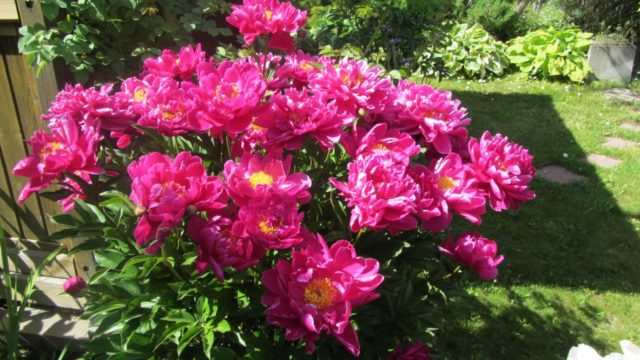
Flowers are large, double, serve as a real garden decoration
Flowering features
Peony Karl Rosenfeld belongs to herbaceous, medium late varieties. Flowering begins in early July and lasts about 2 weeks. Due to its beautiful flowers, the variety is often used for making bouquets. To extend the flowering time when cut, sugar and vinegar are added to the water. In this case, the water is changed daily.
- flowers are arranged singly, double or simple in shape;
- the structure is dense, large, 18 cm in size;
- the color of the flower is dark red with a purple tint;
- petals are large, ribbed, bent in waves;
- The aroma is sweet, attracting butterflies and pollinating insects.
Lush and long flowering depends on the place of growth, climatic conditions and adherence to agricultural practices. If all the care requirements are met, the bush will become a decoration of the summer cottage for a long time.
Application in design
Herbaceous peony Karl Rosenfeld is ideal for the embodiment of designer fantasies
But before decorating a flower garden, it is important to know what the peony is combined with.
Peony planting scheme Karl Rosenfeld:
- 3-4 plants are planted in the center of the flower garden, herbaceous or ground cover plants are placed around it.
- Peony is in perfect harmony with hybrid tea roses. While the rosebush is forming buds, Rosenfeld is already showing lush bloom. After it ends, the rose shows itself in all its glory, and the bright inflorescences look harmoniously against the background of the green foliage of the peony bush.
- Peony Karl Rosenfeld is suitable for creating mixborders. It is planted surrounded by garden geraniums, cuffs, ornamental onions and aquilegia.
- In order for the flower bed to delight the whole season with beautiful flowering, peonies are planted in combination with Siberian iris, large-rhizome geraniums, sedum, yarrow and common mordovia.
Flowers of the Buttercup family are not compatible with herbaceous peonies. Hellebore, anemone, lumbago quickly deplete the soil. Therefore, when growing together, peonies will not show a lush and beautiful flowering.
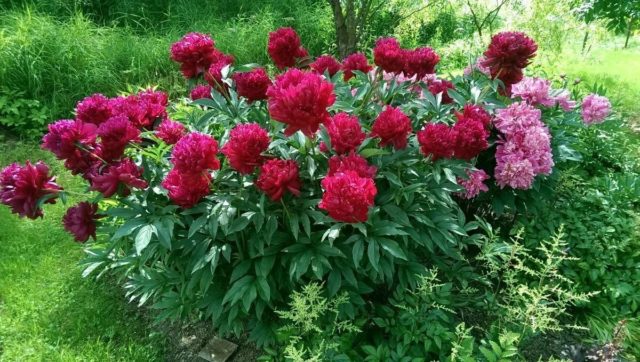
The variety goes well with herbaceous and flowering plants.
When creating a flower garden with a peony of the Karl Rosenfeld variety, it is important to remember that he:
attracts attention;
loves open sun and nutritious soil;
grows in one place for about 20 years;
because of the spreading, it requires a lot of space.
With the right combination of colors, the flower bed will become a decoration of the personal plot, it will bloom from early summer to late autumn.
Peony Monsieur Jules Elie (herbaceous)
It is easy to place an order on our website. Just add the selected products to your cart, and then go to the Cart page, check the correctness of the ordered items and click the "Checkout" or "Quick order" button.
The "Quick order" function allows the buyer not to go through the entire ordering procedure on his own. You fill out the form, and after a short time the store manager will call you back. He will clarify all the conditions of the order, answer questions regarding the quality of the product, its features. It will also tell you about payment and delivery options.
Based on the results of the call, the user either, having received the clarifications, independently places the order, completing it with the necessary items, or agrees to issue it in the form in which it is now. Receives confirmation by mail or mobile phone and waits for delivery.
Checkout in standard mode
If you are sure of the choice, you can place an order yourself by filling out the entire form step by step.
Select the name of your region and town from the list. If you did not find your settlement in the list, select the "Other location" value and enter the name of your settlement in the "City" column. Please enter the correct postcode.
Depending on where you live, you will be offered delivery options. Choose any convenient method.
Choose the best payment method.
Enter information about yourself: name, delivery address, phone number. In the field "Comments on the order" enter information that may be useful to the courier, for example: entrances in the house are counted from right to left.
Check the correctness of the information entered: order items, location selection, customer data. Click the "Checkout" button.
Our service remembers user data, order information and next time will offer you to re-enter the data of the previous order. If the conditions do not suit you, choose other options.
Online order payment
In all parcels, we put the necessary documents and receipts (invoices)
The delivery time is calculated from the moment the order is handed over to the delivery service in working days (on weekdays).
Shipping costs are calculated based on the total weight of the package (includes the weight of the package and marketing investments).
All online payments, except for invoice payments, do not include any commission for the buyer.
When paying by credit card, you will be redirected to the YANDEX KASSA payment gateway. The connection with the payment gateway and the transfer of information is carried out in a secure mode using the SSL encryption protocol. If your bank supports the technology of secure online payments Verified By Visa or MasterCard SecureCode, you may also need to enter a special password to make a payment. This site supports 256-bit encryption. Confidentiality of the provided personal information is provided by YANDEX KASSA. The entered information will not be provided to third parties, except in cases provided for by the legislation of the Russian Federation. Payments by bank cards are carried out in strict accordance with the requirements of the MIR, Visa Int. and MasterCard Europe Sprl.
We deliver all over Russia!
We are ready to send your order to any locality in our country.Immediately upon the arrival of the goods, the transport company will notify you of the possibility of receiving the order.
The order is formed depending on the availability of goods in stores and warehouses, if the goods are out of stock, our manager will contact for approval, we do not replace the goods without agreement with the buyer. It usually takes 1-3 days to complete. Immediately after sending, your order will be accompanied by the current track code, which allows you to track the movement of the order, on the website of the transport company. Also, this code will be available in your account in the orders section.
Sdeck - a transport company, accepts small-sized and large-sized orders for sending, receiving at the point of issue, or by courier.
Boxberry - transport company, accepts small-sized orders for sending, receiving at the point of issue, or by courier.
Post office - transport company, accepts small-sized orders for shipment, pick-up at the point of issue.
Express courier delivery in Moscow - we will deliver on the day of order
Pickup from offices
If you are in Novosibirsk or Moscow, you can place an order and pick it up at our office.
V Moscow we are at st. Yeniseiskaya 7, building 3, building 2, room 5 (Metro Sviblovo) Novosibirsk by the address Shirokaya street 1A, office 215A
You can ask any question you are interested in about the product or the work of the store.
Our qualified specialists will definitely help you.
{SOURCE}
Transplant and reproduction
Wild peonies grow in one place for up to 100 years, but their cultural counterparts need a transplant every 10 years.
When a plant needs to be transplanted or it is necessary to divide a bush, then it is carefully dug out, avoiding mechanical damage to the roots. The root system of peonies is powerful, with a fragile fleshy rhizome with tuberous thickenings. The root lies quite deep for herbaceous plants, so it must be dug out with a pitchfork. Having dug the bush in a circle to a sufficient depth, carefully pry it with a shovel and remove it from the soil.


The removed root is shaken off the ground, washed and placed in the shade, allowing it to wither slightly to get rid of excessive fragility. Old thick roots are cut off at an angle of 45 °, leaving only 10-15 cm in length. Large rhizomes must be divided. To do this, use a peg, which is driven into the middle of the root, after which several parts with eyes are obtained. The division of roots is carried out for plants at least 5-6 years old.
Often the middle of the rhizome of peonies is empty, so each new part must be carefully inspected to remove rotten and damaged places. Treat the sections with a solution of potassium permanganate and sprinkle with fungicide.
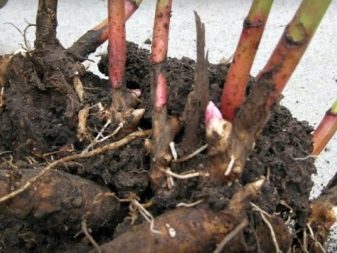

The planting hole is prepared a month before the start of autumn work. In a prepared hole about 60 cm deep, 2/3 is covered with a substrate from a mixture of earth, peat, humus and sand, adding wood ash, superphosphate and a little copper sulfate. Planting is carried out in a prepared hole so that the buds are located at a depth of 3-5 cm. On top of the cut, they cover it with earth and mulch with a layer of peat no more than 5 cm.
Peonies are propagated by dividing the bush and seeds. But due to the fact that it is difficult to obtain the original variety from seeds, this method is used only by breeders to create new plant species. The rest use the division of the bush.
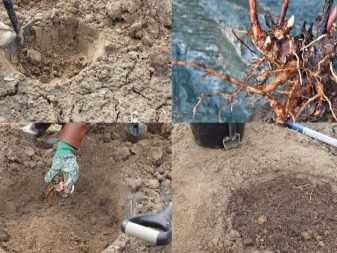

Peonies from divisions bloom in the second or third year, but varietal signs in them can appear only after four or five years with proper care:
- all buds on a one-year-old seedling are completely removed;
- in the second year, one bud is left, waiting for its flowering to see the presence of varietal characteristics, after which it is also removed, cutting it as short as possible;
- such an operation is carried out all subsequent years, waiting for the plant to bloom with the required color.
When this happens, you will never regret the effort and the long wait for the result.
For information on how to plant peonies correctly in autumn and spring, see the next video.
Care features
Like all peony, "Monsieur Jules Elie" loves sunny places and neutral loamy soils. A plant growing in partial shade will also feel good, gaining green mass, but it will not please with beautiful flowering.
Water the plants abundantly, preventing water from stagnating. In the spring, when rapid growth begins, during the formation of buds and the flowering period, as well as at the end of summer, when new buds are laid, peonies need watering. One adult plant requires up to three buckets of water.
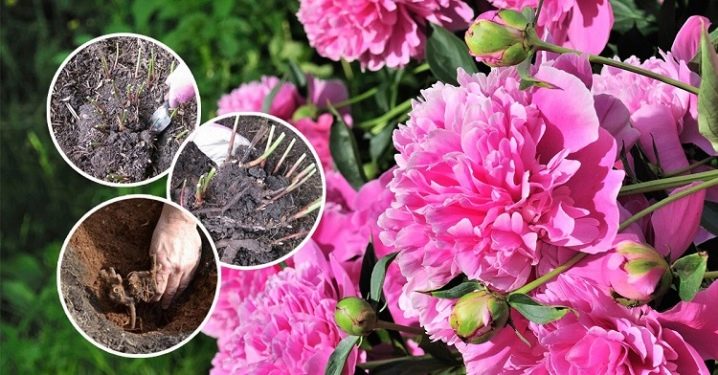
In the spring, after the snow melts, the soil near the bush is disinfected with a solution of potassium permanganate (2-3 g of substance per 10 l of water). One bush needs 5 liters of solution. With the onset of growth, the peony is fed with fertilizers containing ammonium nitrate. Once a month, the bushes are watered over the foliage with a solution of any complete mineral fertilizer (according to the instructions). Laundry soap is added to the water to make the solution stick to the leaves. Alternatively, you can use dry fertilizer by embedding it in a groove around the bush and then watering it.
Autumn comes the time for pruning and transplanting peony bushes, preparing the plant for winter. This does not present any particular difficulties, since Monsieur Jules Elie winters in the open ground, requiring no additional shelter, except for winters, when severe frosts and a small snow cover are expected. However, young plants should be covered during any expected winter.
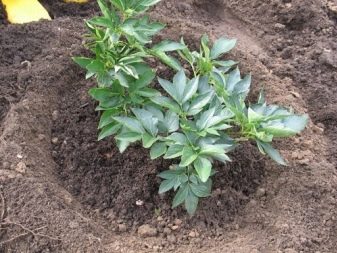
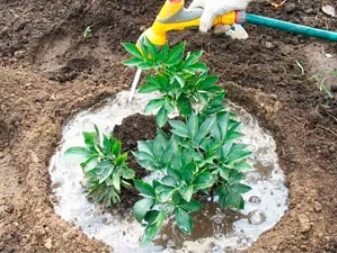
When the leaves and stems of the plant wilt, they are pruned at soil level. All dried tops are burned to prevent the development of diseases and pests. Harmful insects can hide in leaf axils. The treated bush is sprinkled with several handfuls of wood ash.
There are times when peony bushes need to be cut ahead of time. To avoid the death of the plant, the stems are cut so that 3-4 leaves remain on them. This method will allow the plant to lay new buds for the next year.

Features of Terry Bomb Peony
This plant was named in honor of the deity of the ancient Greeks - Peana. Pean healed the Olympian gods from diseases. Most species are also "healers". They are used in the treatment of diabetes mellitus, arthritis. They treat kidneys and cardiovascular system. Used for poisoning, ulcers and varicose veins.
But with the use of this plant as a medicine, one should be careful.
Appearance
The appearance of the terry bomb-shaped peony is good throughout the warm season. This species is a herbaceous perennial. The roots of the plant are tuberous, fleshy. The stems reach a height of up to 1 meter. The sheet has a dissected shape.
Terry Bomb Peony Bush
Flowers have strong doubleness. The saturation of the petals is so great that when fully blooming, the flower looks like a ball or a bomb. It is because of this shape that this species received the name - Terry bomb-shaped peony.
The color can be different.
Care
Care is needed as usual. Despite its beauty, it does not require increased attention to itself. When properly planted, this garden worker will produce lush blooms every year.
Frost resistance
Excellent frost resistance. In winter, even in cold regions, this plant does not freeze out without additional shelter. However, it is better to play it safe - cut the bushes and cover.
Bloom
Flowering is annual, occurs in different varieties at different times.
All varieties of Terry peonies can be divided into certain groups depending on the period of their flowering.
Based on when the plant blooms, peonies are divided into groups:
- from 20 to 31 May - very early;
- from June 1-10 - early;
- from June 16 - medium and late.
Growing from seeds
The plant can be propagated by seed.
How to prepare seeds
Seeds are harvested until mid-September. The selected material is planted in the ground to a depth of 5-7 centimeters.
If the seeds are planned to be planted in the spring, then they are germinated within two months. Then stratification is carried out on the lower shelf of the refrigerator for another 3 months.
How to plant
To plant a plant, the pit is filled with a nutrient mixture of ash, peat, compost.
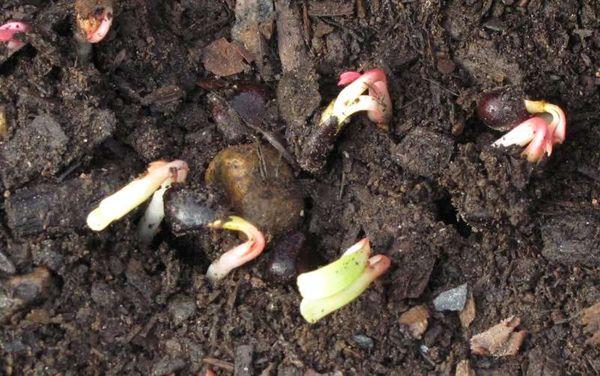
The density and depth of planting depends on the variety.
Spraying
When the first signs of the disease appear, it is necessary to spray with fungicides immediately after flowering. It is recommended to apply the solution to the bush and soil. Then spraying continues once every 10-12 days.
Transfer to separate flowerpots
In the fall, the seedling is placed in a flowerpot with a volume of 5 liters and a height of 50 centimeters. It is stored in a cool room until spring. In the spring, the pot is rearranged on the windowsill, where it remains until the fall. In the fall, the plant is transplanted into open ground.
Temperature and light conditions
For normal flowering, it takes 10 hours of daylight. The optimum temperature range is from 20 to 22 degrees Celsius.
Landing in open ground
In the spring, the crop is planted after the snow melts. The plant has not yet woken up, and the buds have not yet begun to form. The soil for planting is prepared in advance. In autumn, planting is carried out in early September.


